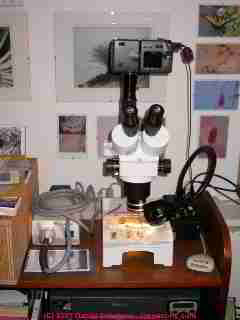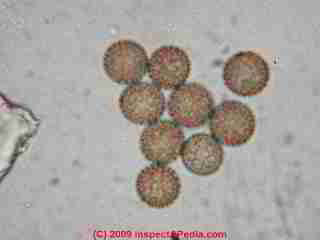 Digital Photography and the Microscope
Digital Photography and the Microscope
How to take successful digital photographs through the microscope
- POST a QUESTION or COMMENT about digital microphotography: how to take succcessful, sharp digital photographs through the microscope
Digital microphotography guide:
The purpose of this paper is to help microscopists and other photographers take high quality digital photographs through the microscope, then store them for easy editing and retrieval, and finally use digital microphotographs as an information or forensic database. We discuss using modern digital cameras and transmitted-light microscopes together.
InspectAPedia tolerates no conflicts of interest. We have no relationship with advertisers, products, or services discussed at this website.
Introduction to Digital Photography and Microscopy
Article Contents
PAAA 2005 Symposium, University of Tulsa, Tulsa Oklahoma - June 2-5, 2005 - updated 02/23/2009 - updated 2015/10/25
Note: the latest version of this document can be found at
InspectAPedia.com/Microscopy/Digital_Photography_by_Microscope.php - © Daniel Friedman All Rights Reserved
[Click to enlarge any image]
The smut spores shown above were photographed using a Polam microscope at 1200x. The image presented in this web article has been reduced in size and resolution for online publishing to permit fast page loading speed. The original photograph permits zooming in for considerable magnification and sharp detail.
See MOLD by MICROSCOPE or see WORLD TRADE CENTER 9-11 DUST PHOTOS
|and also
see POLLEN PHOTOGRAPHS for examples of digital photographs obtained through the microscope with good results.
This article discusses the selection of cameras that adapt well to microscope eyepieces or trinocular heads, and on camera settings and procedures to obtain best quality photographs. We also discuss image resolution and size settings and make recommendations. Cameras used as examples in this paper include the Nikon Coolpix series 990, 995, and 4500.
The techniques discussed in this paper work well with digital cameras and any type of microscope, low power stereo zoom to high power forensic polarized light microscopes.]
Before specifying a camera choice and recommending camera settings let's review the purposes of digital microphotography of particular interest to aerobiologists and other microscopists:
- To develop a large reference library of photo images of known particles - so images will be mostly stored on a computer, in some data base form.[1] Images need to sharp, often with multiple exposures at different focuses.
- For research: to exchange email images with other professionals to obtain assistance in identification - similar to #1 above, but images by email should be reduced in file size for convenience and transmission speed.
- To print with professional reports - usually these are limited in physical size. This is a distant third in importance in our practice.
Some Factors Involved in Obtaining and Using Good Photomicrographs
Start with a well prepared slide, choosing a mountant with good optics for the particles being examined. Fungal spores or pollen grains may benefit from hydration but not excessive hydration. Heavy use of colored stains risks obscures natural colors and features needed for identification, though we may succumb and use fuchsin, lacto phenol, or even India ink for occasional development of certain features.
After a well prepared and clean slide, be sure the microscope is properly set up for Koehler illumination, and be sure the objective is clean.
Select a camera which has a very good lens - among the current crop of 3+megapixel cameras, this is perhaps more important than a higher number of pixels. Lens resolution in macro mode and with the camera focused at infinity are both important.
Post processing of images may improve the image color balance, sharpness, or contrast, but no amount of processing can produce accurate image data if that information was not captured in the first place.
Even excellent photomicrographs are not useful if they cannot be located later for reference purposes. A good photographic data base system is important.
The Digital Image Formation Chain determines image quality in digital photos through the microscope
- Microscope resolution, including the quality, cleanliness, and adjustment of every lens in the light path. Before starting the process be sure the microscope is clean and that K�Koehler illumination has been established.
- Light source (color temperature, focus, etc.)
- Adjustment of the condenser (N>1 oil-rated condenser lens for high magnifications such as the 100x oil-immersion objective - don't forget to oil the top of an oil-rated condenser lens when using the oil objective)
- Adjustment of the field diaphragm, condenser aperture, and where provided, objective aperture and eyepiece aperture)
- Placement of the well-prepared and clean slide on the microscope stage
- Choice of objective lens and use of oil-immersion (higher magnifications reduce the demands on the camera's photo array of pixels)
- Eyepiece and camera mount adjustment (and where provided,
- calibration of the camera lens focal distance to match the eyepiece distance - or infinity)
- Camera resolution
- Camera lens resolution
- Pixel resolution of the camera used
- Camera settings used for image capture
- Camera's focusing or macro-focusing algorithm if it is not being used with lens set at infinity
- Image data compression selection, ranging from zero (tiff) to low-loss, to high-loss compression
- Post capture image processing
- enhancement and cleanup, such as using the "digital camera" or "jpeg" cleanup functions of image management software to remove noise, sharpen edges, adjust color balance, adjust contrast
- dithering algorithm on compressed-image expansion
- Level of image compression, e.g. JPEG, used to store final image - determines file size, maximum print resolution, and limits of ability to crop and enlarge or "zoom" into the image.
- Observation Resolution
- Image display or printing capability, including effects of printer capability, dpi, dot size, dot spacing, ink types, and choice of paper used to prepare the print - but remember, that contrary to the argument of one expert microscopist who teaches that there is no reason to store large images, if you want to be able to crop and enlarge or zoom into an image you need to have recorded the original with sufficient megapixels and resolution.
- Visual resolution ability of the human eye
- The limits of light to resolve particles are pertinent throughout these steps, at the microscope during observation and making of the photograph in particular.
What this list means is that the quality of the end result of photomicrography is limited by the weakest link in the image-formation chain. For example, no amount of camera pixels will provide a sharp image of an object which is not resolved sharply in the microscope nor will a high-pixel camera produce a sharp image if the camera's lens is of limited ability.
Watch out: not all high pixel cameras have equally sharp lenses, so the "resolution" in megapixels can be misleading.
High megapixels defines how many data points of image are being recorded. But if the lens and other steps in the image formation chain are not producing a sharp image, high megapixels means you're recording a lot of fuzzy data.
With these preliminaries, let's look at choosing a camera, selecting camera settings, using mounts, etc.
...
Continue reading at MICROSCOPE CAMERA SELECTION or select a topic from the closely-related articles below, or see the complete ARTICLE INDEX.
Or see these
Articles on Digital Photography in Microscopy
- FORENSIC LAB TECHNICAL PROCEDURES - home
- MICROSCOPE DIGITAL PHOTOGRAPHY
- TECHNICAL & LAB PROCEDURES
- WORLD TRADE` CENTER 9-11 DUST PHOTOS
Suggested citation for this web page
MICROSCOPE DIGITAL PHOTOGRAPHY at InspectApedia.com - online encyclopedia of building & environmental inspection, testing, diagnosis, repair, & problem prevention advice.
Or see this
INDEX to RELATED ARTICLES: ARTICLE INDEX to BUILDING FORENSICS
Or use the SEARCH BOX found below to Ask a Question or Search InspectApedia
Ask a Question or Search InspectApedia
Try the search box just below, or if you prefer, post a question or comment in the Comments box below and we will respond promptly.
Search the InspectApedia website
Note: appearance of your Comment below may be delayed: if your comment contains an image, photograph, web link, or text that looks to the software as if it might be a web link, your posting will appear after it has been approved by a moderator. Apologies for the delay.
Only one image can be added per comment but you can post as many comments, and therefore images, as you like.
You will not receive a notification when a response to your question has been posted.
Please bookmark this page to make it easy for you to check back for our response.
Our Comment Box is provided by Countable Web Productions countable.ca
Citations & References
In addition to any citations in the article above, a full list is available on request.
- In addition to citations & references found in this article, see the research citations given at the end of the related articles found at our suggested
CONTINUE READING or RECOMMENDED ARTICLES.
- Carson, Dunlop & Associates Ltd., 120 Carlton Street Suite 407, Toronto ON M5A 4K2. Tel: (416) 964-9415 1-800-268-7070 Email: info@carsondunlop.com. Alan Carson is a past president of ASHI, the American Society of Home Inspectors.
Thanks to Alan Carson and Bob Dunlop, for permission for InspectAPedia to use text excerpts from The HOME REFERENCE BOOK - the Encyclopedia of Homes and to use illustrations from The ILLUSTRATED HOME .
Carson Dunlop Associates provides extensive home inspection education and report writing material. In gratitude we provide links to tsome Carson Dunlop Associates products and services.


